|
| |
NEPAL INFORMATION
Weather
- Best Time To Go - Places to See and more
KHUMBU VALLEY TRAIL and VILLAGES]
Peak
Freaks Expeditions
CLIMBING
TREKKING
PHOTO
GALLERY
WHEN IS THE BEST TIME TO GO
TO NEPAL?
Climate factors are
very important in deciding on a visit to Nepal. October-November, the start of
the dry season, is in many ways the best time of the year in Nepal. With the
monsoon only recently finished the country-side is green and lush and Nepal is
at its most beautiful. Rice is harvested and there are some more important and
colorful festivals to enjoy. At this time of the year the air is sparkling
clean, visibility is unexcelled and the Himalayan views are as near perfect as
you can ask. Further more the weather is still balmy, neither too hot nor too
cold. For obvious reasons, this is also the peak tourist season.
In December-January the
temperatures and visibility are still good, though it can get very cold.
Trekkers need to be well prepared, as snow can be encountered on high-altitude
treks. Heading for the Everest Base Camp at this time of the year can be a real
feat of endurance and the Annapurna Circuit trek is often closed by snow on the
Thorang La pass. Down in Kathmandu the cheaper hotels, where heating is
non-existent, are often chilly and gloomy in the evenings. There's sometimes a
brief winter monsoon, lasting just a day or two in January.
February-March-April,
the tail end of the dry season, is good second-best time. The weather gets
warmer so high-altitude treks are no longer as arduous, although by the end of
the dry season, before the monsoon breaks, it starts to get too hot for comfort.
Visibility is not good as earlier in the dry season since the country is now
very dry, and dust in the air reduces that crystal Himalayan clarity. In
compensation, Nepal's wonderful rhododendrons and many other flowers are in
bloom so there's plenty of color to be seen along the trekking trails.
May and the early part
of June are not the best months as it is extremely hot and dusty and the coming
monsoon hangs over you like a threat. Mid-June to September, when the monsoon
finally arrives, is the least popular time to visit Nepal. The rains wash the
dust out the air, but the clouds obscure the mountains so you're unlikely to
enjoy more than a rare glimpse of Himalaya. Although it doesn't rain all day it
usually does rain everyday and the trails will be muddy and plagued by leeches.
Despite this, it is possible to trek during the monsoon, although high rivers
may further complicate matters and it's certainly not as pleasant as other times
of the year. Landslides sometimes block roads during the monsoon but many
visitors still come to Nepal form India as the weather is even less pleasant
down on the plains. The latter part of the monsoon, the months of
August-September, are a time of festivals which will certainly enliven a visit
to Kathmandu.
Location:
Nepal borders with the Tibet Autonomous
Region of the People's of China in the North and India in the East, South and
West respectively.
Area:
147,181 sq. Kilometers
Altitude:
Varies from 70 meters to 8848 meters
Capital:
Kathmandu
Population:
approx. 22 million
Language:
Nepali is the national language of Nepal.
Educated people understand and speak English as well.
Time:
Nepali is the national language of Nepal.
Educated people understand and speak English as well.
Climate:
Nepal has four major seasons.
(1) Winter: December-February,
(2) Spring: March-May,
(3) Summer: June-August,
(4) Autumn: September-November.
Nepal can be visited all year round
People and
Religion: Nepalese
people are mainly divided into two distinct groups, the Indo-Aryans and the
Mongolians. Kathmandu Valley is the spiritual and cultural meeting point
of all these groups. Nepal is the only Hindu Kingdom in the World.
Hindu Temples and Buddhist shrines are scattered all over the kingdom.
Nepal is the birthplace of Lord Buddha, the Light of Asia. Hindus and
Buddhists live together harmoniously in Nepal.
Currency and
Foreign Exchange: Nepali Rupee notes come in
Rs. 1, 2, 5, 10, 20, 25, 50, 100, 500, 1000
denominations. Coins come 5p, 10p, 25p, Rs. 1, 2, 5 denominations. Foreign
currencies must be exchanged only through the banks or authorized foreign
exchange dealers. The receipts from such transaction are to be obtained
and retained. Visitors can exchange foreign currency at the foreign
exchange counter at the airport upon arrival. Visitors other than the
Indian national have to make the payment in foreign currency in hotel, travel
agencies or trekking agencies and air tickets. Non-Indian visitors are not
allowed to import or export Indian currency. The approximate value of one
USA dollar is equivalent to Rs. 73.65 as of January 30, 2001.
Entry Procedure:
All visitors except the Indian nationals must hold a passport and a valid visa.
The visas can be obtained at the Nepalese Diplomatic Missions and Consulates
abroad and entry points issue visa for visitors. The visa will be extended
at the Department of Immigration.
Entry: A visa is necessary to enter Nepal and
can be obtained for the following duration from any Royal Nepalese Embassy or
Consulate or at the entry points in Nepal.
1. The single entry tourist visa can be obtained from the entry points of Nepal
or from the Royal Nepalese diplomatic missions abroad by paying US$30 for 60
days.
2. If the visitors, who has already visited Nepal under tourist visa, intends to
come again within 15 days of the same visa year he/she can obtain entry visa by
paying US$50 for 30 days at the entry points or at the Royal Nepalese diplomatic
missions abroad.
3. The
visitors who wish to stay for more that 60 days in Nepal can extend their
tourist visa by paying the equivalent of US$50 in the Nepalese currency for 30
days from the Department of Immigration.
4. Business visa with multiple entry facility for the period of one year and
five years can be obtained from the Department of Immigration on the
recommendation of Ministry of Industry by paying the equivalent of US$250 and
US$100 respectively in the Nepalese currency for the foreign investors.
ENTRY
POINTS: By Air:
Tribhuvan International Airport, Kathmandu
By Land: (1) Kakarbhitta (2) Birgung
(3) Belhiya (Bhairahawa) (4) Nepalgung (5) Dhangadi (6) Jogbani (Biratnagar) and
(7) Mahendra Nagar in Nepal-India border and (8) Kodari in Nepal-China border.
The overland tourists entering the kingdom with their vehicles must possess an
international carnet.
Customs
formalities: All
baggage must be declared and cleared through the customs on the part of entry.
Personal effects are permitted free entry. The duty on articles brought by
the visitor varies according to the volume and value of the goods. A
tourist may bring in dutiable goods, such as tobacco and liquors, within the
prescribed quantity free of duty. Carrying narcotics, arms and ammunition
are strictly prohibited. Visitors can export souvenirs to their respective
countries. The export of antiques requires special certificate from the
Department of Archaeology, National Archive Building, Ram Shah path, Kathmandu
(Tel: 215358). Gold, silver, precious stones, wild animals and their
skins, horns, wild flora and fauna etc. and all drugs whether processed or
in their natural state are prohibited to export.
Travel
route: Royal
Nepal Airlines the national flag carrier of Nepal and other International
airlines operate scheduled flights to Kathmandu from Abu Dhabi, Bangkok, Bombay,
Calcutta, Doha, Delhi, Dubai, Dhaka, Paro (Bhutan),
Varanasi, Frankfurt, Paris, Hong Kong, Karachi, London, Moscow, Singapore,
Osaka, Lhasa and Vienna. The International Airlines operating their
flights to Kathmandu include Aeroflot, Biman Bangladesh Airlines, China South
West Airlines, Druk Air, Gulf Air, Indian Airlines, Lufthansa, Pakistan
International Airlines, Qatar Airways, Singapore Airlines and Thai
International.
Airport
tax: International tax now including in your arriving airline ticket.
Airport
transportation: In
addition to metered taxis, limousine service is also available at the airport
for transport to major hotels in the city. Cost to Kathmandu is approximately Rs.
200.
Other
transport services: Metered
taxis having black plates with white figures are available in Kathmandu.
Metered tempo (three wheeler scooters) is also available and is slightly cheaper
than taxis. Bicycle, motorcycles and rickshaws are also available on hire.
The fare for the bicycles or motorcycles is fixed where as the fare of rickshaws
is to be negotiated. There are regular bus services between the main town
and interiors of the Kathmandu valley. The Bus Terminal is located at
Gongabu (new bus terminal) and Bagbazar (old but terminal). Similarly,
scheduled bus services for outside the valley operate from the Gongabu Bus
Terminal which is located near Balaju, Kathmandu
Facilities:
Nepal has every type
of accommodation facilities that a tourist might ask for. This ranges from
the international standard star hotels to budget hotels and lodges.
Similarly one can also have a choice of sightseeing from a range of different
tour packages. In order to have an assured quality service it is advisable
to use the facilities and services of government-registered hotels, lodges,
travel agencies the licensed tour guides only and engage an authorized
travel/trekking agency.
Major tourist
attractions:
Very few countries
in the World can offer as many varieties of adventure tourism packages as Nepal.
Of the 14 peaks above 8000 meters in the World, eight are located in Nepal.
It is the land of Sagarmatha (Mount. Everest 8848 meters), the highest peak in
the World and other 1310 mountain peaks which are opened for expeditions.
Nepal has thousands of such peaks, which are yet to be conquered by the
expeditions. For those who cannot withstand the rigorousness mountain climbing
there are mountain flights, which fly around the Mt. Everest and provide a close
look of the top of the World. From Nagarkot (32 kilometers East of
Kathmandu) and Daman (80 Kilometer southwest of Kathmandu) one can have a
distant view of Mt. Everest and beautiful Himalayan range. Trekking is the
best way to get to interesting and remote mountain villages of Nepal and to
enjoy views of the focused peaks together with their lifestyle untouched by
modern civilization.
The river
rafting which is known as White Water Adventure represents another major
attractions. With distance of 100 miles, one can see the topographical
variations with the river rising from the higher points near Nepal - Tibetan
border and then dropping dramatically to lower levels the plains bordering
India. For those who wish to view wildlife, Nepal offers plenty of scope.
There are eight National Parks and four Wildlife Reserves and two Conservation
Area in Nepal.
For the less
adventure, Pokhara the lake-city of Nepal has no equal as it provides ample
opportunities for fishing, swimming, canoeing and boating along with the
sightseeing of majestic panoramic views in its background. It is only Pokhara, a
tropical spotty with an altitude of about 900 meter from where one can see the
mountain crossing over 8000 meters from such a short distance of about 40
kilometers. For the nature lovers Nepal is such a land of natural beauty
that metaphors cannot delineate its real picture.
At the same time, Nepal proffers an incomparable scope to the scholars and
connoisseurs of art and culture to see and study the different aspects of fine
arts be it painting, sculpture, woodcarving or architecture .Kathmandu valley
possesses several historical monuments, old place and palace squares, shrines
and temples. Ageless tradition and legends all make it a living museum
that any visitor would cherish its vivid memory in his/her heart forever.
Nepal is the land of Lord Pashupatinath, which is the holiest Hindu temple in
the World. Besides, two out of the four main holy places (Chhetras) of
Hindu pilgrimages namely Muktichhetra and Varahachhetra, are located in Nepal.
Not only for the Hindus but also for the Buddhists, Nepal offers a unique place
of pilgrimage as it happens to be the birthplace of Lord Buddha, the apostle of
peace and compassion. Nepal is the Land of festivals with some part of the
Kingdom or the other celebrating festival everyday of the year. Festivals
may be linked with the remembrance of the departed soul, to herald the different
seasons, to mark the beginning or end of the agricultural cycle, to mark the
national events, or just family celebrations. On a festive day the
Nepalese take their ritual bath, worship different gods and goddesses, visit
temple, observe fasting and undertake feasting. The most important aspect
of Nepalese culture is the religious harmony and understanding prevailing among
the Hindus and Buddhist. Some of the major festivals of Nepal are:
Places
to Visit
KATHMANDU
CITY
 Kathmandu
is known as Kantipur, the kingdom of Nepal. Here you will visit the temple of
the living Goddess, who acknowledges the greetings of her devotees from balcony
of her temple residence, Kathmandap-the source of the name Kathmandu. It was
allegedly made from the timber of a single tree. Next, on to the Durbar Square
area with its array of temples overlooked by the Hanuman Dhoka Palace, the
ancient palace of the Nepalese Royalty. Kathmandu
is known as Kantipur, the kingdom of Nepal. Here you will visit the temple of
the living Goddess, who acknowledges the greetings of her devotees from balcony
of her temple residence, Kathmandap-the source of the name Kathmandu. It was
allegedly made from the timber of a single tree. Next, on to the Durbar Square
area with its array of temples overlooked by the Hanuman Dhoka Palace, the
ancient palace of the Nepalese Royalty.
Pashupatinath
Lying 6 Km from central Kathmandu, Pashupatinath temple is one of the holiest
Hindu temples dedicated to Lord Shiva. Situated amidst a lush green natural
setting on the bank of the sacred Bagmati river, the temple, which was built in
pagoda style, has a gilded roof and beautifully carved silver doors. Visitors
will be permitted to view the temple from the east bank of the Bagmati river, as
entrance into the temple is strictly forbidden to all non-Hindus. Pashupatinath
is the centre of an annual pilgrimage on the day Shivaratri, which falls in
February or March. Behind the temples are the cremation grounds.
Dakshinkali
Literally meaning the Kali of the south, this temple is dedicated to the Goddess
Kali, the Hindu goddess of power. Goats, chickens, ducks etc. are sacrificed on
Tuesdays and Saturdays. The temple itself is located in a forested canyon and
lies 19 Km. from Kathmandu.
Boudanath
This stupa, situated 11 Km. from the center of Kathmandu, is one of the biggest
in the world of its kind. It stands with four pairs of eyes in the four cardinal
directions, keeping a lookout for righteous behavior and human prosperity. This
Buddhist stupa was built by King Man Deva at the advice of the Goddess Mani
Jogini. It is built on an octagonal base and is contains inset prayer wheels.
The shrine is surrounded by the homes of Lamas, or Buddhist priests.
Swayambhunath
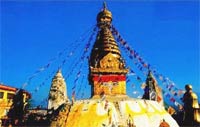 Located
approximately 3km from the center of Kathmandu, this Buddist stupa is said to be
2000 years old. The stupa which forms the main structure is composed of a solid
hemisphere of brick and earth which supports a lofty conical spire capped by a
pinnacle of gilt copper. Located
approximately 3km from the center of Kathmandu, this Buddist stupa is said to be
2000 years old. The stupa which forms the main structure is composed of a solid
hemisphere of brick and earth which supports a lofty conical spire capped by a
pinnacle of gilt copper.
Painted
on the four sided base below the spire are the all seeing eyes of lord Buddha.
The whole area around the Stupa contains an array of small stupas and temples.
This is one of the best places from which to view the Kathmandu valley, as it is
situated an a small hillock.
BHAKTAPUR
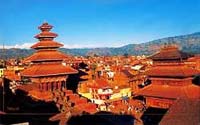 Also
known as BHADGAON meaning the city of devotes, this place is the home of
medieval art and architecture. Lying 14Km east of kathmandu city. This place was
founded in the 9th century and is shaped like a conch shell. The city is at the
height of 4600 ft. Above sea level. In Bhaktapur you will visit the Durbar
Square with its array of temples overlooked by the palace of 55 Windows built by
King Bupatindra Malla, the Nytapola Teple. This temple, which was also built by
king Bhupatindra Malla, is the best example of the Pagoda style and stands on
five terraces, on each of which stands a pair of figures, famous strong men,
elephants, lions, griffins and goddesses. Time permitting, a visit to the museum
of Thanka painting can also be considered. A 30 minute walk brings you to the
Dattatraya temple and Pujari Math which can also be done provided there is
plenty of time at the clients' disposal. Also
known as BHADGAON meaning the city of devotes, this place is the home of
medieval art and architecture. Lying 14Km east of kathmandu city. This place was
founded in the 9th century and is shaped like a conch shell. The city is at the
height of 4600 ft. Above sea level. In Bhaktapur you will visit the Durbar
Square with its array of temples overlooked by the palace of 55 Windows built by
King Bupatindra Malla, the Nytapola Teple. This temple, which was also built by
king Bhupatindra Malla, is the best example of the Pagoda style and stands on
five terraces, on each of which stands a pair of figures, famous strong men,
elephants, lions, griffins and goddesses. Time permitting, a visit to the museum
of Thanka painting can also be considered. A 30 minute walk brings you to the
Dattatraya temple and Pujari Math which can also be done provided there is
plenty of time at the clients' disposal.
Nagarkot
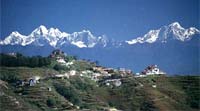 It
is situated about 35Km. east of Kathmandu city and from here one can see Mt.
Everet and other peaks of the Himalayas. Nagarkot is located between Kathmandu
valley in the west and Indravati in the east. It
is situated about 35Km. east of Kathmandu city and from here one can see Mt.
Everet and other peaks of the Himalayas. Nagarkot is located between Kathmandu
valley in the west and Indravati in the east.
The
top of Nagarkot commands accelerating views in all direction. The altitude of
Nagarkot is 2229Mt. Above from sea level. It is also very popular for the
viewing sunrise and sunset.
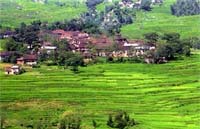 Dhulikhel Dhulikhel
It is situated at an altitude of 1600 m. above from sea level and 32 Km. From
Kathmandu City. Dhulikhel is famous for its vantage location in viewing the
Himalayan ranges, from Cho Oyu in the east to Himalchuli in the west. It is
popular for viewing the sunrise and sunset.
Patan
5 Km. away from Kathmandu city. Patan, also known as Lalitpur, is a city of fine
arts, enclosed within 4 stupas, which are said to have been built in the 3rd
century A.D. by Emperor Ashoka.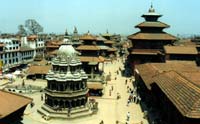
You
will see Durbar square, the Patan durbar (palace), which houses a bronze
collection, the Krishna temple built by King Siddi Narsinh Malla, Hiranya Varna
Mahavihar, and Mahaboudha Temple.
A
trip to the Tibetan Refugee Centre and the Handicraft Centre will be included
during your visit to Patan, where you will witness the hand weaving of Tibetan
carpets and molding of metal statues.
Pokhara
Valley
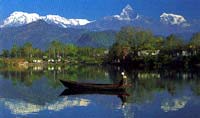 Pokhara
is Nepal's second most popular tourist destination and its adventure capital. It
is overshadowed by a massive wall of the Himalayas, and dominated by the
towering peak of the Annapurna range. Even more impressive is the fishtailed
pinnacle of Mt. Machhapuchhare (6977 mt.) For the adventurous, the massif of Mt.
Dhaulagiri (8167m) waits to be explored. Pokhara is the starting point for the
most famous treks in Nepal, in the Annapurna area. Pokara is situated 200 K.M.
west of Kathmandu. Pokhara
is Nepal's second most popular tourist destination and its adventure capital. It
is overshadowed by a massive wall of the Himalayas, and dominated by the
towering peak of the Annapurna range. Even more impressive is the fishtailed
pinnacle of Mt. Machhapuchhare (6977 mt.) For the adventurous, the massif of Mt.
Dhaulagiri (8167m) waits to be explored. Pokhara is the starting point for the
most famous treks in Nepal, in the Annapurna area. Pokara is situated 200 K.M.
west of Kathmandu.
What
to See
Phew Lake:
The second largest
lake in the kingdom, this is the center of attraction in Pokhara. The eastern
shore, popularly known as lake side, or Baidam, is the favorite hang out for
travelers, and is where most of the hotels, restaurants, and handicraft shops
are located.
Begnas & Rupa Lake - The lakes offer the perfect natural retreat because of
their relative seclusion. Splendid boating and fishing opportunities can be had
here.
Barahi
TempleThe most important religious monument in Pokhara, built almost in the middle of
Phewa Lake, this two storied pagoda is dedicated to the manifestation of Ajima,
the protectress deity who represents the female force.
Seti Gandaki
Flowing right
through the city, this turbulent river runs completely underground in places.
Amazingly, at certain points, the river hardly appears to be two meters wide,
but it is quite deep, up to over 45 meters.
Devils
Fall Locally known as
"Pataley Chhango", this is an awesome waterfall lying about two km.
southwest of Pokhara airport. Legend has it that a trekker (Devin David….) was
washed away by the Pardi Khola (river) and mysteriously disappeared down into an
underground passage beneath the fall.
Mahendra Gupha
(cave) Another of
nature's wonders in Pokhara is the Mahendra Gupha. This large limestone cave is
locally known as the house of bats, which is an apt name for it. A two hour walk
to the north of Pokhara, it is best to bring your own torch in order to see the
stalactites and stalagmites, as well as the local winged residents.
Lumbini
The
birth place of Lord Buddha
Nepal
is well known to the world as the sacred birth place of Lord Buddha as it is
famous for its mountains and monuments. It attained a high level of civilization
and prospwerity, and its acclaim is well deserved. Buddha was born into a royal
family. Immediately after his birth, he took seven steps in the four cardinal
directions, and wherever he set foot, a divine lotus flower bloomed.
The main attraction at Lumbini is the Secred Garden, which is spread out over 8 sq
km and contains all of the treasures of this historical area. The Mayadevi
temple is the main attraction for pilgrims and archaeologists alike. Here we
find a bas relief that shows Mayadevi, the Buddha’s mother, giving birth to
him. Standing west of the Mayadevi shirine is the oldest monument in Nepal, the
Ashoka Pillar. The pillar was erected by Emperor Ashoka in order to commemorate
his pilgrimage to the sacred site.
HOLIDAYS
|
New
year's Day
|
April
( First day of Baisakh)
|
|
|
Matatirtha
Aaunsi ( Mother's Day )
|
April
|
|
|
Buddha
Jayanti
|
April
|
|
|
Machhendtanath
Rath Jatra
|
May-June
|
|
|
Guru
Poornima
|
August
|
|
|
Gaijatra
|
August-September
|
|
|
Krishnashtami
|
August-September
|
|
|
Gokarna
Aunsi or Father's Day
|
August-September
|
|
|
Indra
Jatra
|
September
|
|
|
Bada
Dashain
|
September
-October
|
|
|
Tihar
|
October-November
|
|
|
Bala
Chaturdashi
|
November-December
|
|
|
Bansanta
Panchami
|
January-February
|
|
|
Maha
Shivaratri
|
March-April
|
|
|
Ghode
Jatra
|
March-April
|
|
Govt.
Office-Hour:
|
From
|
To
|
Day
|
Month
|
|
9
AM
|
5
PM
|
Mon-Fri
|
February
to mid to November mid
|
|
9
PM
|
4
PM
|
Mon-Fri
|
November
mid to February mid
|
|
Banks:
|
|
|
|
|
9
AM
|
3:30
PM
|
Mon-Fri
|
Round
the year
|
Note: Government
offices and banks are closed on Saturdays, Sundays and other
official Holidays.
|
Nepal Embassies
|
|
Country
|
Address
|
Telephone
|
|
Australia
|
Bansbari, Kathmandu
|
4371678, 4371279
|
|
Bangladesh
|
Naxal, Kathmandu
|
4414943
|
|
British
|
Lainchaur, Kathmandu
|
4411590, 4414588
|
|
China
|
Balawater, Kathmandu
|
4411740, 4411958
|
|
Denmark
|
Balawater, Kathmandu
|
4413010, 4413020
|
|
Egypt
|
Pulchowk, Lalitpur
|
5524812, 5524844
|
|
Finland
|
Lazimpat, Kathmandu
|
4416636, 4417221
|
|
France
|
Lazimpat, Kathmandu
|
4412332, 4414734
|
|
Germany
|
Gyaneshwar, Kathmandu
|
4412786, 4416527
|
|
India
|
Lainchaur, Kathmandu
|
410900, 411699
|
|
Israel
|
Lazimpat, Kathmandu
|
411811, 413419
|
|
Japan
|
Panipokhari, Kathmandu
|
410397, 414083
|
|
Korea, North
|
Jhamsikhel, Lalitpur
|
535871, 521084
|
|
Korea, South
|
Tahachal, Kathmandu
|
270172, 270417
|
|
Myanmar
|
Chakupat, Lalitpur
|
521788, 521634
|
|
Pakistan
|
Panipokhari, Kathmandu
|
4410565, 4411421
|
|
Russia
|
Baluwater, Kathmandu
|
4411063, 4412155
|
|
Sri Lanka
|
Baluwater, Kathmandu
|
4417406, 4413623
|
|
Thailand
|
Bansbari, Kathmandu
|
4371410, 4371411
|
|
USA
|
Panipokhari, Kathmandu
|
4412718
|
Electricity:
220 Voltages
Communication:
Communication
facility available in the popular trekking route:
|
|
|
|
Everest Region:
|
|
Namche
|
Telephone
|
|
Khunde
|
Telephone
|
|
Lukla
|
Telephone
|
|
Tyangboche
|
Telephone
|
|
Pheriche
|
HF
Radio, HRA, Satellite Phone
|
|
Lobuche
|
Satellite
Phone
|
|
Gokyo
|
Satellite
Phone
|
Medical
facility:
Medical facility available in the popular Trekking route:
|
Everest Region:
|
|
Lukla
|
Govt.
Hospital-Doctor
|
|
Khunde
|
Hillary
Hospital-Doctor
|
|
Pheriche
|
HRA
Aid-post-Doctor
|
The Garbage:
THE GARBAGE'S
ARE DIVIDED INTO THREE CATEGORIES:
1. Disposable in the Khumbu Region which are
incinerable and biodegradable:
a. Toilet paper
b. Cardboard boxes and paper waste
c. Bamboo baskets and mats
d. Cotton and jute bags
e. Spoiled food
2. Recycling materials:
a. Tins, bottles jars and plastic containers
b. Plastic and foil bags and sheeting's.
c. Reusable cooking gas cylinders
d. Gas Canisters
3. Re-exportable goods;
a. Used oxygen bottles
b. Used batteries
c. Climbing equipment's such as tents, personal gear etc.
Economy Overview
Nepal is among the poorest and least developed countries in the world with
almost one-third of its population living below the poverty line. Agriculture is
the mainstay of the economy, providing a livelihood for three-fourths of the
population and accounting for 38% of GDP. Industrial activity mainly involves
the processing of agricultural produce including jute, sugarcane, tobacco, and
grain. Security concerns relating to the Maoist conflict have led to a decrease
in tourism, a key source of foreign exchange. Nepal has considerable scope for
exploiting its potential in hydropower and tourism, areas of recent foreign
investment interest. Prospects for foreign trade or investment in other sectors
will remain poor, however, because of the small size of the economy, its
technological backwardness, its remoteness, its landlocked geographic location,
its civil strife, and its susceptibility to natural disaster.
Labour Force
Number in labour force: 10.4 million note: severe lack of skilled labor (2004
est.)
Sectors: agriculture: 76% industry: 6% services: 18%
Unemployment: 42% (2004 est.)
GDP Facts and Figures
Currency: Rupee (NRp)
GDP: $39.14 billion (2005 est.)
GDP Per Capita: $1,400 (2005 est.)
GDP Real Growth: 2.7% (2005 est.)
GDP Composition: agriculture: 38% industry: 21% services: 41% (2005 est.)
Industries and Land Use
Industries: tourism, carpet, textile; small rice, jute, sugar, and oilseed
mills; cigarettes, cement and brick production
Land use: arable land: 16.07% permanent crops: 0.85% other: 83.08% (2005)
Exports: carpets, clothing, leather goods, jute goods, grain

About Us

|